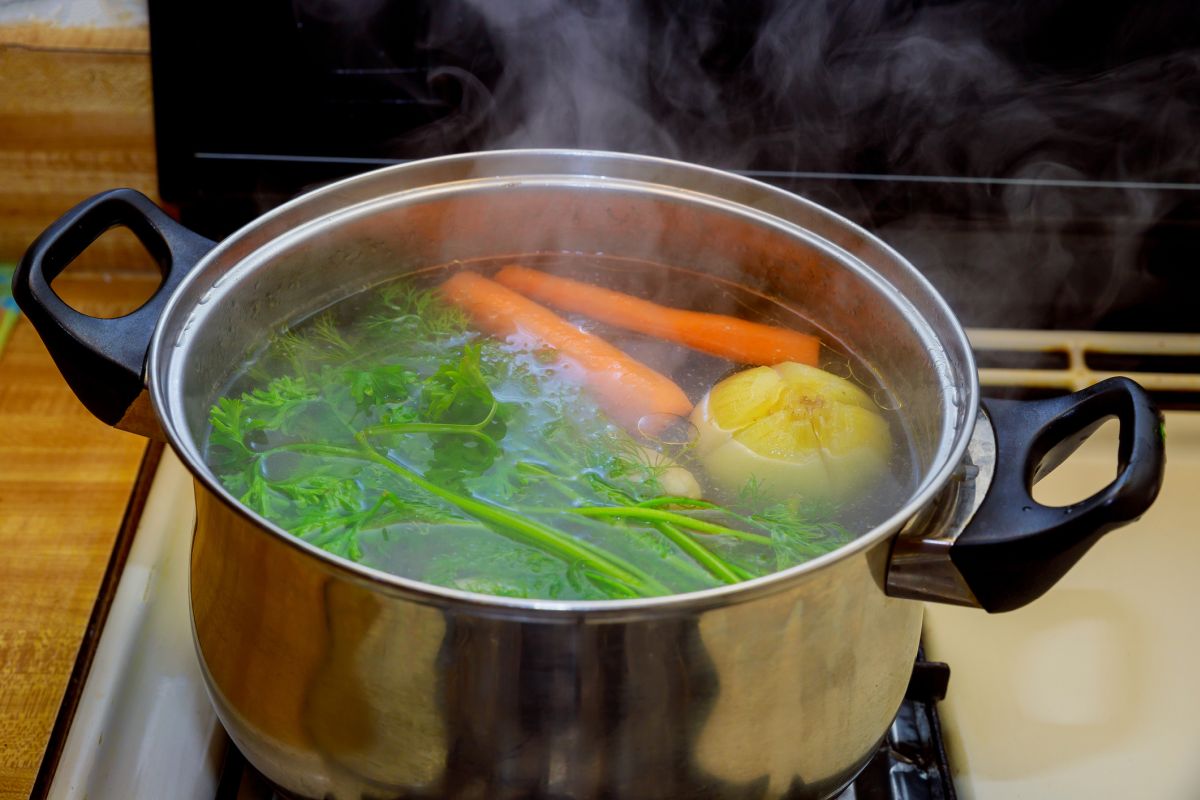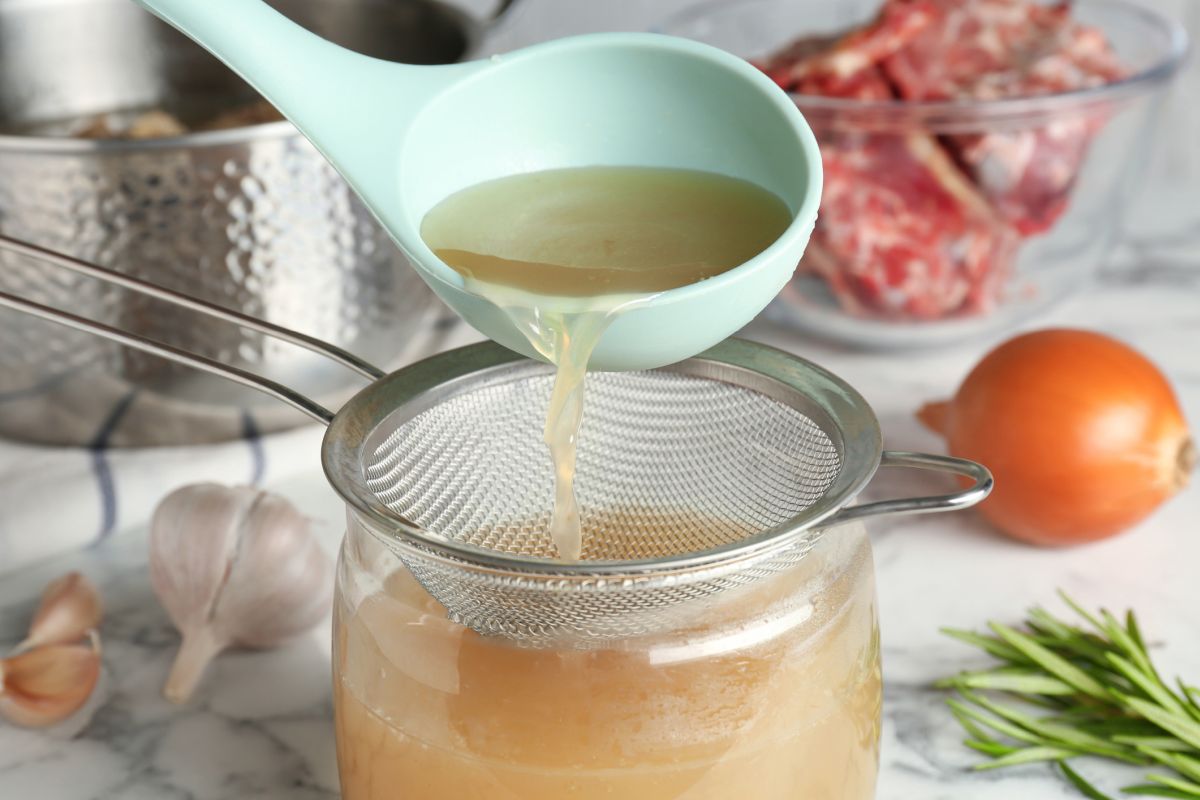There are many differences to consider when looking at stock vs. broth. Using stock or broth is a great way to add some extra flavor to a recipe.

What Is Stock?
Stock is made by simmering bones, aromatics, and herbs. It’s also made with a combination of onions, carrots, and celery, which is known as regular mirepoix. You can also use a combination of onions, fennel, leeks, and celery, which is known as white mirepoix. While the bones cook, gelatin releases, which gives the stock a rich flavor.
Stock is a key ingredient often used to make soups, stews, sauces, gravies, and more. It can also add flavor to beans, rice, pasta, or grains. Stock typically isn’t eaten or served on its own.
How To Make Stock
Step 1. Combine the bones and aromatics
To make your own homemade stock, put your preferred animal bones into a large pot filled with 6 quarts of cold water. Along with the animal bones, add carrots, celery, onion, parsley, leek greens, garlic, and black peppercorns to the large pot.
Step 2. Simmer and skim the stock
Lower the heat on the stove to allow the bones and aromatics to simmer and cook. Occasionally, skim away the fat. Do this until the stock has reduced by 1/3.
Step 3. Strain the stock
To strain the stock, you can use a slotted spoon or tongs to remove any large vegetable or bone pieces. After, strain the stock by using a fine-mesh sieve. Strain the stock into a different large stock pot.
Step 4. Cool and store the stock
After straining the stock, let it cool completely. You can cover and store it in the refrigerator or store it in the freezer. If you store it in the refrigerator, it lasts for a maximum of three days. If you store the stock in the freezer, it will last for a maximum of 3 months.
Dishes Made With Stock
Stock can be added to soups, sauces, stews, and more.
- Chicken and broccoli with dill sauce
- Artichoke florentine pasta
- Pressure-cooker chicken with olives and artichokes
- Cauliflower mash
- Barbecue chicken sliders
- Butternut squash soup
- Chicken dumplings
- Vegetable stir-fry
- Lemon cranberry quinoa salad
- Thai chicken casserole
What Is Broth?
Broth is made by simmering meat and vegetables. Its main difference from stock is that broth is made without any bones. Since there are no bones involved in the broth-making process, broth takes less time to make.
Benefits of Broth
Bone broth has nutritional value and is hydrating because of the amount of water. Because of the flavor of bone broth, it can help you feel full and can be an addition to a healthy lifestyle. Since bone broth is made with vegetables, you also get nutrients from the carrots, celery, and more.
How To Make Broth
Step 1. Combine the ingredients
Combine your preferred meat, vegetables, herbs, and peppercorns, and put those into a large pot. Pour enough water into the pot so that the meat and other contents are covered completely. Heat the water so it’s a little under a boil over medium to high heat.
Step 2. Simmer the broth
After heating the water so it’s just under a boil, reduce the heat to a low simmer. You want to see only 1 or 2 bubbles break at the water’s surface over the course of a minute.
Step 3. Skim the broth
While simmering the broth, skim or remove any fat from the surface with a ladle or a different utensil. Let the meat cook until it’s cooked through but not dry.
Step 4. Separate the meat and bones
Continue simmering the broth as you remove any meat and bones from the pot.
Step 5. Strain the broth
After separating the meat and bones, strain the rest of the broth into a pot or a different non-reactive container.
Step 6. Cool the broth
Cool the broth by filling the sink with ice and cold water. The sink should be about half full once you put the broth into the ice bath.
Step 7. Store the broth
You can store the broth in your freezer or refrigerator. If stored in the refrigerator, broth can last for up to 5 days. If the broth hasn’t been used over the course of the 5 days, make sure to bring the broth to a boil before using.
Dishes Made With Broth
The most common recipes that you will find using broth are soups, stews, and chilis. Adding broth to a dish can add sweetness or more savory flavors to a number of dishes.
- Homemade chicken noodle soup
- Chicken tortellini soup
- Chicken stew
- Roasted tomato basil soup
- Garlic parmesan chicken alfredo
- Tuscan white bean soup
- Spicy creamy chicken pasta
- Ginger carrot soup
- Red curry soup with noodles
- Chicken white bean chili
What Are Bouillon, Bone Broth, and Consummé?
Bouillon
Bouillon cubes, granules, or pastes are made from dehydrated broth or stock. These cubes, granules, or pastes can be dissolved in water in order to make broth or can be added to already existing broth or stock.
Bone Broth
In order to make bone broth, you can simmer collagen-rich bones and aromatics in water. Many bone broth recipes require you to rub the bones with tomato paste and roast them. Since bone broth simmers longer than stock, bone broth is usually saltier and more flavorful.
Consummé
Comsummé is a kind of stock or broth that is made when you remove any impurities. The common types of comsummé include beef, tomato, veal, fish, and chicken. You can eat comsummé on its own at the start of a meal in the form of a light appetizer.
Difference in How They’re Made: Stock vs. Broth
While stock is made by simmering animal bones, broth is reliant on different kinds of meat for flavoring. Broth takes less time to simmer and has a less robust flavor compared to stock. Stock can have a deep flavor because of the mirepoix and aromatics.
The major difference between stock and broth is that broth is made from meat and vegetables, whereas stock is made with bones. Broth takes less time to cook, which makes it have a thinner texture compared to stock. Since stock is made by using bones, the heat during the cooking process coaxes out the gelatin and other kinds of flavor.
Difference in How They’re Used: Stock vs. Broth
When comparing stock vs. broth, the difference in how they are used is in the flavor either one adds to a dish. Stock and broth can be used interchangeably but you do want to pay attention to sodium levels depending on the recipe you are using. Since stock has a stronger flavor, it is better at adding body to a dish. You can use broth when you want other flavors of a dish to stand out.
Healthier Choice: Stock vs. Broth
Whether homemade or store-bought, stock is considered to be the healthier choice since it is higher in protein and comes with less sodium per serving. Stock does contain more calories, fat, and carbohydrates compared to broth. Despite stock having less sodium than broth, the regular store-bought stock is not considered to be a low-sodium product.
One way to control the amount of sodium in stock or broth is by making the stock or broth from scratch. You get more control over how much sodium you put into the broth. On their own, stock or broth isn’t considered to be a significant source of protein.


Leave a Reply